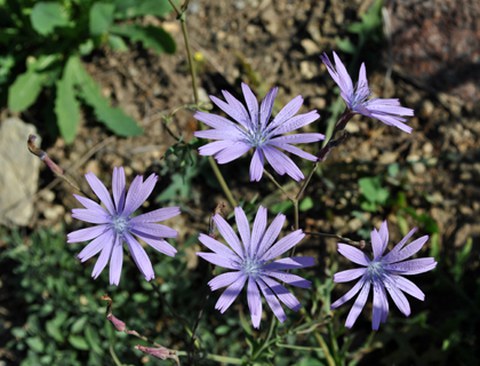Boselgarten
Inhaltsverzeichnis

Blick von der Bosel nach Sörnewitz
Geschichte
Anfang des 20. Jahrhunderts bearbeitete der bedeutende Botaniker Prof. Oskar Drude, Leiter des Botanischen Instituts und des Botanischen Gartens der Technischen Hochschule Dresden, die Pflanzengesellschaften des Elbhügellandes. Dieses Gebiet umfasst das Elbtal und seine Randhöhen zwischen Pirna und Hirschstein. Gegenüber dem übrigen Sachsen weist es höhere Durchschnittstemperaturen und geringere Niederschläge auf. Viele hier vorkommende Wärme und Licht liebende Pflanzenarten wanderten nach der Eiszeit aus den Steppengebieten Südost-Europas in das Gebiet ein. Klimaänderungen und der langsamer nachziehende Wald verdrängten sie später auf Rückzugsstandorte. Typische Beispiele solcher Rückzugsgebiete im Raum Meißen sind die Knorre, der Göhrisch-Felsen und die Bosel.
Abgesehen von der botanischen Bedeutung war der Boselfelsen von jeher markantes Wahrzeichen der Region und beliebter Aussichtspunkt. 1904 ging der Steinbruch am Boselfelsen an die Firma Dümling über. Der Besitzerwechsel hatte eine so starke Intensivierung des Abbaus zur Folge, dass Heimatfreunde und Botaniker um den Standort fürchten mussten. Da man sich damals noch nicht auf Naturschutzgesetze berufen konnte, erwarb der „Landesverein Sächsischer Heimatschutz“ (LSH) auf Anraten Prof. Drudes und mit Unterstützung des Meißener Verschönerungsvereins 1908 ein Flurstück nahe der Abbruchkante - die Keimzelle des heutigen Boselgartens. Damit war dem Steinbruch eine Eigentumsgrenze gesetzt. Die bedrohten Pflanzenarten konnten bewahrt werden und sollten sich vom Garten aus wieder ausbreiten. Von 1928 bis 1930 verwirklichte der Drude-Schüler Prof. Arno Naumann die heute noch in weiten Teilen gültige Konzeption des Boselgartens.
Dem Wirken des LSH ist auch der endgültige Erhalt der Boselspitze zu verdanken: Das erste Reichsnaturschutzgesetz 1935 ermöglichte es, den Steinbruch an massive Auflagen zu binden; dies führte nach langjährigen Bemühungen des LSH um einen Erwerb des Steinbruchgeländes 1943 zum Erfolg. Die Kaufsumme betrug 50.000 RM – ein stattlicher Betrag für eine Vereinigung von Privatleuten mitten im II. Weltkrieg. 1948 wurde der gesamte Besitz des LSH an der Boselspitze als Naturdenkmal unter Schutz gestellt. Das umgebende Spaargebirge genießt seit 1974 den Status eines Landschaftsschutzgebietes. Nach der widerrechtlichen Enteignung des LSH 1949 fiel der Boselgarten der „Hauptverwaltung Staatliche Schlösser und Gärten“ zu. 1957 wurde der Garten dank der Initiative von Dr. Thielemann aus Meißen und Prof. Herbert Ulbricht, Botanik-Professor an der Technischen Hochschule, eine Außenstelle des Botanischen Gartens Dresden und erlangte damit eine solide Grundlage für die Zukunft.

Blick in den Garten
Pflanzensammlung
Der Boselgarten zeigt auf einer Fläche von insgesamt ca. 2.500 m² etwa 800 verschiedene Pflanzenarten. Den Schwerpunkt bilden bis heute die wärmeliebenden (=thermophilen) Arten des Elbhügellandes. Die morphologischen Formen der Anpassung an Trockenheit kann man im Garten gut beobachten. Neben Pflanzen, die der Wanderer im landschaftlich schönen Elbtal noch relativ häufig findet, zeigt der Garten viele Arten, die am natürlichen Standort selten geworden oder gar ausgestorben sind. Etwa 200 von ihnen stehen auf der Roten Liste Sachsens: So kann der Besucher im oberen Gartenteil z. B. die beiden Graslilien-Arten (Anthericum liliago und A. racemosum), den Blutroten Storchschnabel (Geranium sanguineum), den Blauen Lattich (Lactuca perennis), die Wiesen-Kuhschelle (Pulsatilla pratensis ssp. nigricans), das Felsen-Fingerkraut (Drymocallis rupestris) oder seltene Gräser wie die Erd-Segge (Carex humilis) oder das Steppen-Lieschgras (Phleum phleoides) finden.
Ähnliche klimatische Verhältnisse wie im Elbhügelland herrschen im nahegelegenen Böhmen und Thüringen. Die geographische Lage (Einwanderung von Pflanzen aus dem Osten bzw. Westen) und eine größere Häufigkeit kalkreicher Böden ließen dort eine besonders reichhaltige thermophile Flora entstehen. Der mittlere Teil des Boselgartens zeigt Pflanzen, die im Elbhügelland fehlen, aber in Thüringen und/oder Böhmen heimisch sind. Hier finden sich so attraktive Stauden wie der Diptam (Dictamnus albus), das Frühlings-Adonisröschen (Adonis vernalis) und verschiedene Federgras-Arten (z.B. Stipa pulcherrima), die den aufmerksamen Besucher zur Zeit der Samenreife mit einem raffinierten Mechanismus der Samenausbreitung überraschen.
Um im Boselgarten langfristig zum Erhalt ausgewählter gefährdeter Arten beizutragen, sind besondere Maßnahmen nötig: Wir kultivieren z. B. von der Violetten Königskerze (Verbascum phoeniceum) und der Bologneser Glockenblume (Campanula bononiensis) eine größere Zahl von Individuen mit möglichst großer genetischer Breite unter Bedingungen, die den Naturstandorten möglichst nahe kommen. Ausgangsmaterial ist Saatgut aus dem Raum Meißen, dessen Herkunft genau dokumentiert ist. Diese Erhaltungskulturen sowie eine kleine Sammlung früher in Sachsen heimischer und inzwischen z. T. vom Aussterben bedrohter Ackerunkräuter findet der Besucher auf den Terrassen in der Nähe der unteren Gartenpforte. Hier wachsen z. B. Kornrade (Agrostemma githago), Feldlöwenmaul (Misopates orontium) und die Saat-Wucherblume (Glebionis segetum).
Besucherinformation
Der Boselgarten ist vom 1. April bis zum 3. Oktober jeden Mittwoch, Samstag und Sonntag von 10 bis 17 Uhr geöffnet. Besuche außerhalb der regulären Öffnungszeiten sind nach Absprache möglich.
Der Boselgarten schliesst am Mittwoch, den 24.09.2025 bereits um 16.30 Uhr!
Die Monate Mai und Juni sind die günstigste Zeit, um die typischen Vertreter des Gartens in Blüte zu erleben: Viele der gezeigten Pflanzen sind bestrebt, die Frühjahrsfeuchte auszunutzen und ihre Entwicklung bis zur Samenreife abzuschließen, ehe die sommerliche Trockenperiode einsetzt.
Anfahrt

Parkmöglichkeiten und Fußwege zur Bosel.
- Elbradweg bis Sörnewitz
- S-Bahn bis Coswig, weiter mit dem Regionalbus bis Sörnewitz
- S-Bahn bis Meißen, weiter mit dem Stadtbus Linie A bis Oberspaar
- PKW-Abstellmöglichkeiten am Meissner Boselweg und an der Meißner Straße (siehe Karte)
- die Fußwege zum Boselgarten sind ausgeschildert
 © Botanischer Garten Dresden
© Botanischer Garten Dresden
Boselgarten bei Meißen
Eine verschlüsselte E-Mail über das SecureMail-Portal versenden (nur für TUD-externe Personen).
Postadresse:
Technische Universität Dresden Botanischer Garten - Boselgarten Stübelallee 2
01307 Dresden
Öffnungszeiten:
- Mittwoch:
- 10:00 - 17:00
- Samstag:
- 10:00 - 17:00
- Sonntag:
- 10:00 - 17:00
Öffnungszeiten gelten vom 1. April bis 3. Oktober. Einschränkungen siehe gegebenenfalls unter Besucherinformation!



